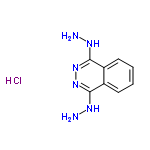-
Name
2,3-dihydrophthalazine-1,4-dione dihydrazone monohydrochloride
- EINECS
- CAS No. 63868-75-7
- Density
- Solubility
- Melting Point
- Formula C8H10 N6 . Cl H
- Boiling Point
- Molecular Weight 226.669
- Flash Point
- Transport Information
- Appearance
- Safety Poison by ingestion, intraperitoneal, and intravenous routes. When heated to decomposition it emits very toxic fumes of NOx and HCl.
- Risk Codes
-
Molecular Structure
- Hazard Symbols
- Synonyms 1,4-Phthalazinedione,2,3-dihydro-, dihydrazone, monohydrochloride (9CI)
- PSA 101.88000
- LogP 2.54960
Dihydralazine hydrochloride Chemical Properties
IUPAC Name: (4-hydrazinylphthalazin-1-yl)Hydrazine hydrochloride
Molecular Formula: C8H11N6Cl
Molecular Weight: 226.70
Einecs: 264-519-6
Freely Rotating Bonds: 2
Polar Surface Area: 38.74 Å2
Flash Point: 345.9 °C
Enthalpy of Vaporization: 95.58 kJ/mol
Boiling Point: 648.3 °C at 760 mmHg
Vapour Pressure: 1.09E-16 mmHg at 25°C
The Cas Register Number of Dihydralazine hydrochloride is 63868-75-7. The chemical synonyms of Dihydralazine hydrochloride (CAS NO.63868-75-7) are 1,4-Dihydrazono-1,2,3,4-tetrahydrophthalazine hydrochloride (1:1) ; 1,4-phthalazinedione, 2,3-dihydro-, dihydrazone, hydrochloride (1:1) . The molecular structure of Dihydralazine hydrochloride (CAS NO.63868-75-7) is .
.
Dihydralazine hydrochloride Uses
Dihydralazine hydrochloride (CAS NO.63868-75-7) is used in organic synthesis.
Dihydralazine hydrochloride Toxicity Data With Reference
| 1. | orl-rat LD50:350 mg/kg | RPOBAR Research Progress in Organic Biological and Medicinal Chemistry. 2 (1970),283. | ||
| 2. | ipr-rat LD50:270 mg/kg | RPOBAR Research Progress in Organic Biological and Medicinal Chemistry. 2 (1970),283. | ||
| 3. | ivn-rat LD50:167 mg/kg | RPOBAR Research Progress in Organic Biological and Medicinal Chemistry. 2 (1970),283. | ||
| 4. | ipr-mus LD50:290 mg/kg | JPETAB Journal of Pharmacology and Experimental Therapeutics. 101 (1951),368. |
Dihydralazine hydrochloride Safety Profile
Poison by ingestion, intraperitoneal, and intravenous routes. When heated to decomposition it emits very toxic fumes of NOx and HCl.
Related Products
- Dihydralazine hydrochloride
- Dihydralazine sulphate
- 63869-51-2
- 63869-92-1
- 63870-23-5
- 63870-39-3
- 63870-40-6
- 63870-51-9
- 6387-15-1
- 6387-17-3
- 63872-05-9
- 6387-27-5
Hot Products
About|Contact|Cas|Product Name|Molecular|Country|Encyclopedia
Message|New Cas|MSDS|Service|Advertisement|CAS DataBase|Article Data|Manufacturers | Chemical Catalog
©2008 LookChem.com,License: ICP
NO.:Zhejiang16009103
complaints:service@lookchem.com Desktop View